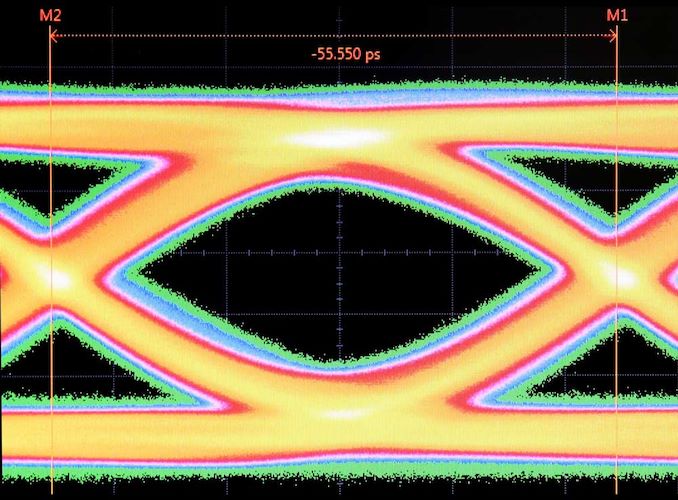Rambus Demonstrates GDDR6 Running At 18 Gbps
by Anton Shilov on November 1, 2019 1:00 PM EST
While GDDR6 is currently available at speeds up to 14Gbps, and 16Gbps speeds are right around the corner, if the standard is going to have as long a lifespan as GDDR5, then it can't stop there. To that end, Rambus this week demonstrated operation of its GDDR6 memory subsystem at a data transfer rate of 18 GigaTransfers/second, a new record for the company. Rambus’s controller and PHY can deliver a peak bandwidth of 72 GB/s from a single 32-bit GDDR6 DRAM chip, or a whopping 576 GB/s from a 256-bit memory subsystem, which is what we're commonly seeing on graphics cards today.
The Rambus demonstration involved the company’s silicon-proven GDDR6 PHY implemented using one of TSMC’s 7 nm process nodes, accompanied by Northwest Logic’s GDDR6 memory controller and GDDR6 chips from an unknown maker. According to a transmit eye screenshot published by Rambus, the subsystem worked fine and the signals were clean.
Both GDDR6 controller and PHY can be licensed from Rambus by developers of SoCs, so the demonstration is both a testament to how well the company’s highly-integrated 7 nm GDDR6 solution works, and a means to promote their IP offerings.
It is noteworthy that Rambus, along with Micron and a number of other companies, has been encouraging the use of GDDR6 memory in products besides GPUs for quite some time. Various accelerators for AI, ML, and HPC workloads as well as networking gear and autonomous driving systems greatly benefit from the technology's high memory bandwidth and are therefore a natural fit for GDDR6. The demonstration is meant to show companies developing SoCs that Rambus has a fine GDDR6 memory solution implemented using a leading-edge process technology that can be easily integrated (with the help of engineers from Rambus) into their designs.
For the graphics crowd, Rambus’ demonstration gives a hint of what to expect from upcoming implementations of GDDR6 memory subsystems and indicates that GDDR6 still has some additional room for growth in terms of data transfer rates.
Related Reading:
- Micron, Rambus, & Others Team Up To Spur GDDR6 Adoption in Non-GPU Products
- Cadence Tapes Out GDDR6 IP on Samsung 7LPP Using EUV
- Samsung Updates on GDDR6 Portfolio: 8 Gb and 16 Gb at Multiple Speeds
- Samsung Pre-Announces 16 Gbps GDDR6 Chips for Next-Gen Graphics Cards
Source: Rambus










24 Comments
View All Comments
eastcoast_pete - Saturday, November 2, 2019 - link
How about the latency of that "fastest GDDR6"? If they reduced that, it might see more non-graphics use.One of the reasons why GDDR memory isn't typically used as system RAM even in systems where build costs are secondary is that graphics memory typically has a lot more latency than DDR4, DDR3, etc. I always wondered how that longer latency affects consoles like the XBox OneX and the PS4 Pro, which use GDDR also to feed the CPU part.
drexnx - Sunday, November 3, 2019 - link
hasn't 16gbps GDDR6 been out for a while now? the 2080 Super ships with it downclocked to 15.5gbps from the factoryGreat_Scott - Monday, November 4, 2019 - link
I'm not really excited by (G)DDR6. Yay more bandwidth.Bummer that latency, which is really important, manages to stay about the same regardless of the memory technology employed. I don't recall the exact article (it was probably AT) that found that the latency numbers worked out to be roughly equal regardless of memory standard.
IIRC it was a DDR3/DDR4 comparison article that focused on the numbers as CAS went up over time.
WaltC - Wednesday, November 6, 2019 - link
I'll never forget the RDRAM/JEDEC debacle. No Rambus for me, sorry--likely they've stolen it somewhere and then patented it, and then they'll sue the OEM who invented it just to put icing on their corroded cake...;) Ugh. Patents should be like trademarks--you don't use 'em in a product you manufacture--you lose 'em. Patent trolls should all be deported to back alleys in Tijuana--near the dog-fighting pits, preferably.